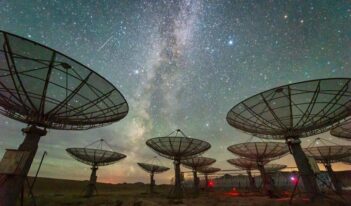
Scholars discuss potential solutions to fill the gaps in the regulatory framework governing space mining.
“That’s one small step for man, one giant leap for mankind,” Neil Armstrong said when he first walked on the moon in 1969. Although many historians consider that moment as the conclusion of the Space Race between the United States and the Soviet Union, some scholars argue that mankind is on the cusp of a new space race.
The space economy is expected to be worth $1.8 trillion by 2035. Scientists anticipate the mining of near-Earth asteroids and the Moon to emerge as a key aspect in the commercialization of space over the next several years. As a result, scholars increasingly are faced with the question of how best to regulate the future of space exploration and extraction.
In 1967, the United Nations Office for Outer Space Affairs created the primary regulatory framework for space, the Outer Space Treaty (OST). Article I of the OST states that the “exploration and use” of outer space and celestial bodies must be for the benefit of all countries and “shall be the province of all mankind.” The United Nations Office for Outer Space Affairs tried to make these provisions more explicit and expansive in 1984 with the Moon Agreement. Article 11 of the Moon Agreement states that the natural resources of the Moon and other celestial bodies in the Solar System are the “common heritage of mankind,” and that the natural resources should not be owned by any state, organization, or individual.
Although most scholars agree that the Moon Agreement would prohibit space mining, the treaty is not generally viewed as enforceable in international law. As of April 2024, only 17 nations have ratified the Moon Agreement, and none have conducted a lunar landing.
That leaves the OST as the only binding international treaty on the topic. But many nations and scholars debate its applicability to space mining and resource extraction. The debate focuses on two questions: whether “exploration and use” includes space mining, and whether the provisions apply to private entities.
Russia and China have argued that the OST prohibits resource extraction and ownership, while the United States and Luxembourg have enacted legislation that permits these activities. For example, in 2015, the United States passed the U.S. Commercial Space Launch Competitiveness Act, which grants private companies engaging in commercial activities in space private property rights over any resources they obtain from celestial bodies.
These laws sparked debate in the United Nations Committee on the Peaceful Use of Outer Space, and Russia argued that all space resource laws should be made by the committee. In response, the United States created the Artemis Accords with the intention of negotiating for the rights to space mining through multiple bilateral and multilateral agreements with other nations.
This week’s Saturday Seminar examines suggested solutions to the regulatory gaps in outer space mining.
- In their article in the University of Mississippi Law School’s Journal of Space Law, Fengna Xu, Jinyuan Su, and Miqdad Mehdi of China’s Xi’an Jiaotong University School of Law recommend that new legal regimes apply the fundamental principles of the OST to modern geopolitics. Xu, Su, and Mehdi recognize that because the OST was created over 50 years ago, the drafters did not consider space mining, and the OST cannot properly apply to our current technological landscape. Xu, Su, and Mehdi caution that without regulation, the limited nature of resources would advantage nations already capable of space mining and disadvantage developing nations. For these reasons, they advocate regulations to prevent monopolies, guarantee legal certainty, and ensure environmental sustainability.
- Recent trends in space law suggest that a binding international treaty governing space law resources is unlikely, argues Melissa de Zwart, Stacey Henderson, and Michelle Neumann of Australia’s Flinders University in an article in Acta Astronautica. De Zwart, Henderson, and Neumann note that because gaps exist in international space law, domestic legislatures from individual countries aim to regulate space resource activities. In addition to domestic efforts, de Zwart, Henderson, and Neumann highlight several multinational agreements that attempt to interpret international space law principles, including by ensuring transparency, cooperation, and equal access to outer space. De Zwart, Henderson, and Neumann explain that as competition over resources increases, consensus over the legal framework for space resource activities will become increasingly necessary.
- Although many scholars see a multilateral approach to regulating space resource extraction as the best way to protect the equity between spacefaring and non-spacefaring nations, Florian Rabitz of Lithuania’s Kaunas University of Technology argues in an article in the International Journal of the Commons that significant barriers hinder the feasibility of such a regime. Rabitz explains that political disagreements inhibit efforts to create binding, multilateral agreements. To avoid these hurdles, Rabitz proposes alternative methods of governance, such as a goals-based approach where the international goal of promoting fairness and equity serves as a catalyst for future development of an international regime. Alternatively, Rabitz suggests that the United Nations establish nonbinding standards and best practices that private actors may implement voluntarily.
- In an article in Space Policy, Olaf Steffen of the German Aerospace Center contends that as the development of the private space economy grows, balanced regulation of space mining becomes increasingly necessary. Steffan outlines several proposed regulatory mechanisms, including requiring companies to pay fees for the rights to mine resources. Steffan argues, however, that adding additional costs for mining businesses could become burdensome on already expensive projects. Instead, Steffan proposes that mining rights should be granted based on the disclosure of exploration data and thereafter remain tradable. He emphasizes that the interests of investors and less-developed states should be central to policymaking, and accordingly supports sharing mining resources for the benefit of global industry, scientific research, and human well-being.
- Privatization of extraterrestrial resources can be beneficial if regulated properly, Karan Singh Chouhan of India’s Christ University explains in an article in the CMR University Journal for Contemporary Legal Affairs. Chouhan embraces privatization and argues that under a laissez-faire approach, privatization leads to prosperity and innovation. Yet, although militarization of space is prohibited under the OST, Chouhan realizes that militarization is a logical end of privatization. The International Seabed Authority, intended to promote peace and regulate resource extraction in the sea, can serve as a model for space, Chouhan adds. Chouhan recognizes that capitalism is not the perfect ideology, but argues that current commons governance models, such as the International Seabed Authority, can provide safeguards to promote peace in space.
- In a comment in Emory Law Journal, Laura C. Byrd of Emory Law School argues that new space regulatory regimes should incorporate environmental impact assessments because of the environmental consequences of space mining. Byrd points out that rare metals mined on Earth for renewable energy are more abundant in space, and that mining these resources in space would protect Earth’s environment. But she cautions that treating space as an unlimited resource will likely lead to overexploitation. Byrd further explains that although greenhouse gas emissions from rockets are currently low, the expansion of the space mining industry could increase emissions from spacecraft exiting and re-entering Earth’s atmosphere. These possibilities, she concludes, make necessary the incorporation of environmental consciousness in space regulations.



